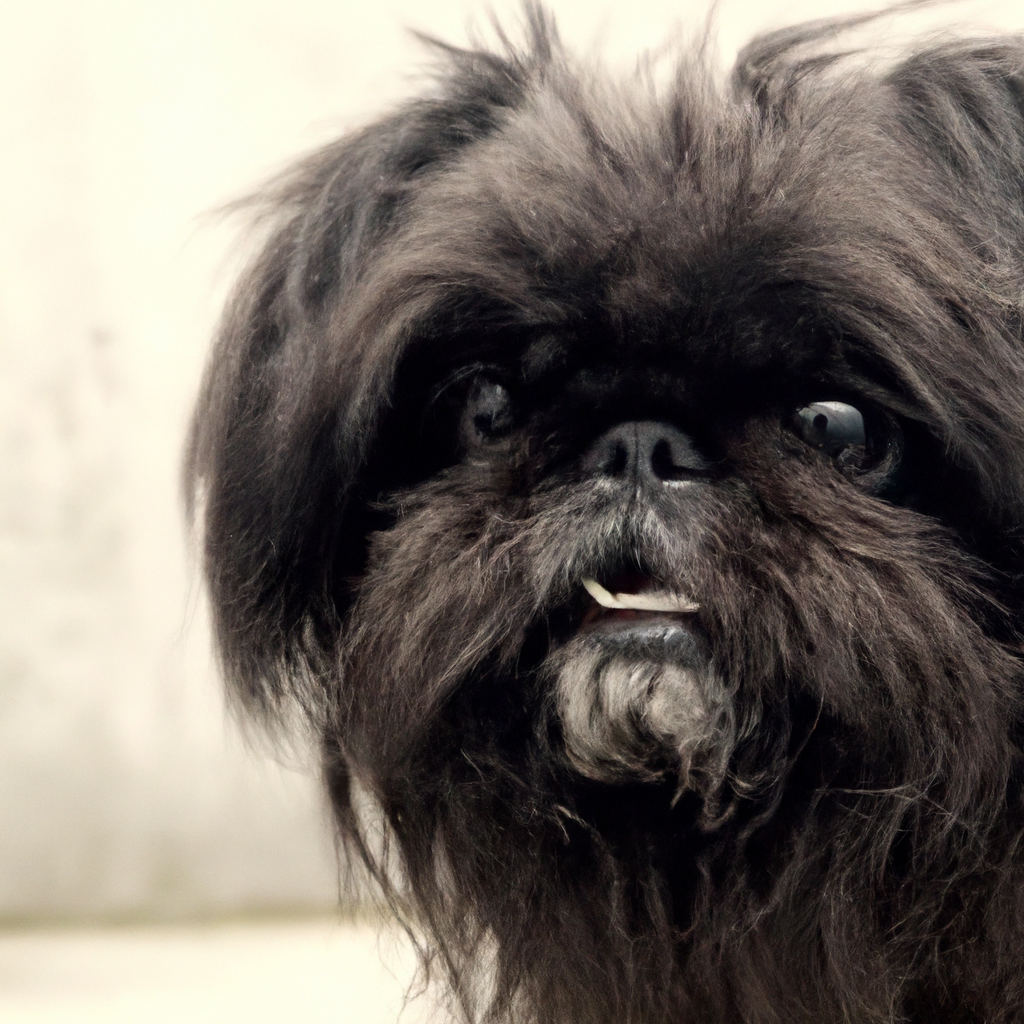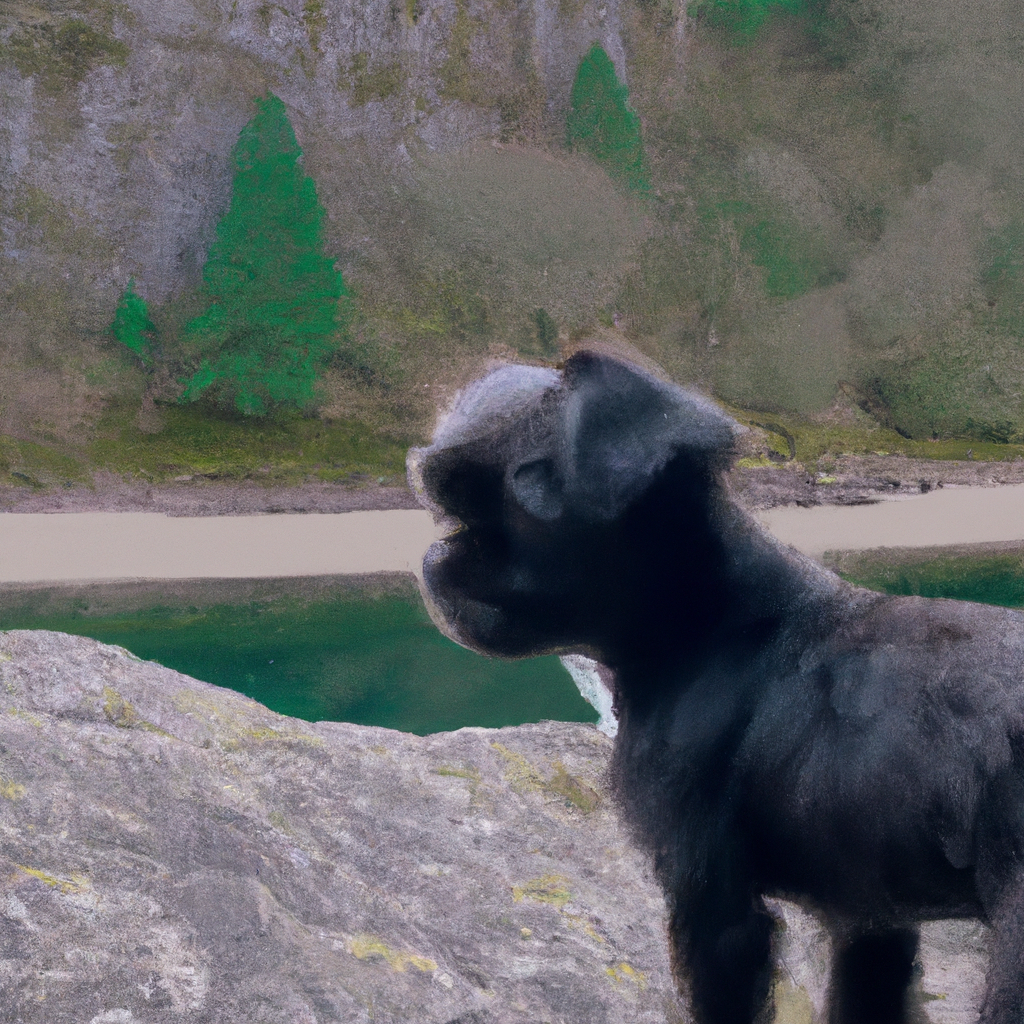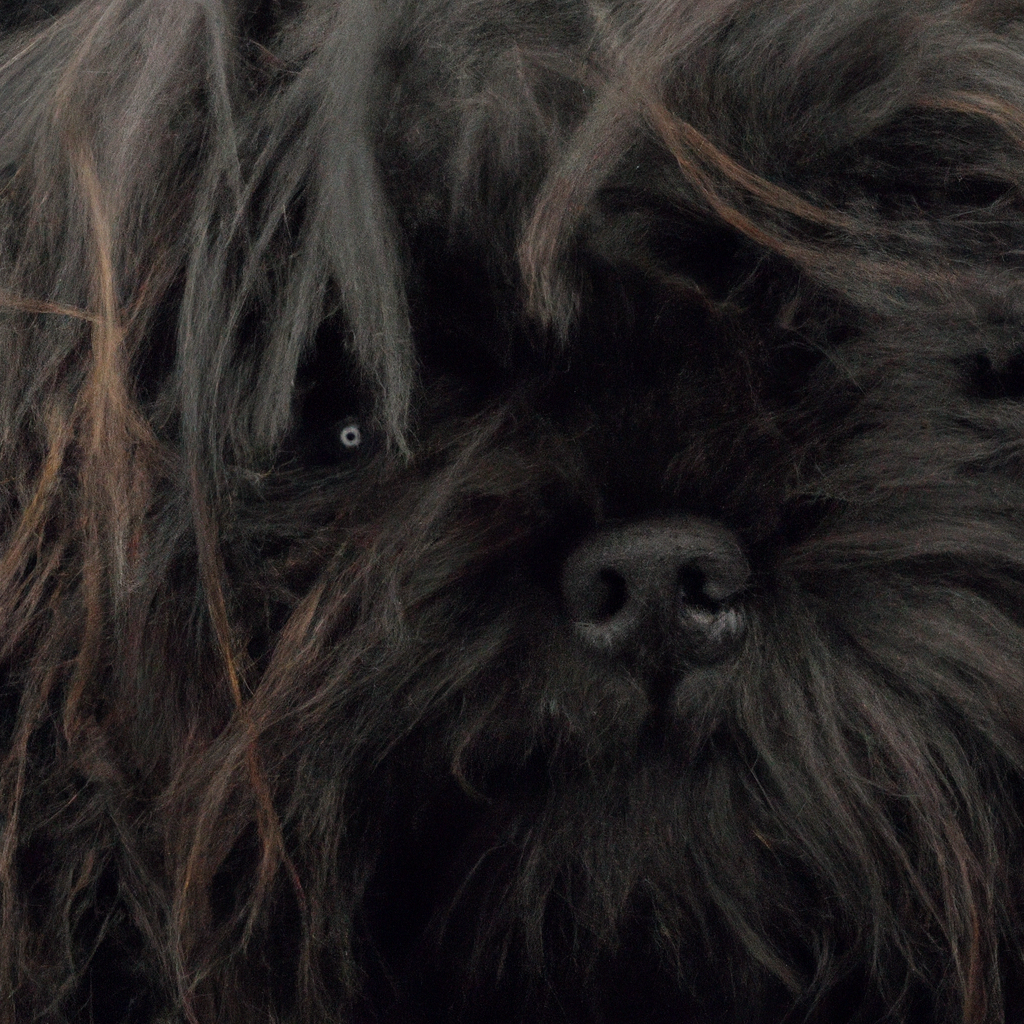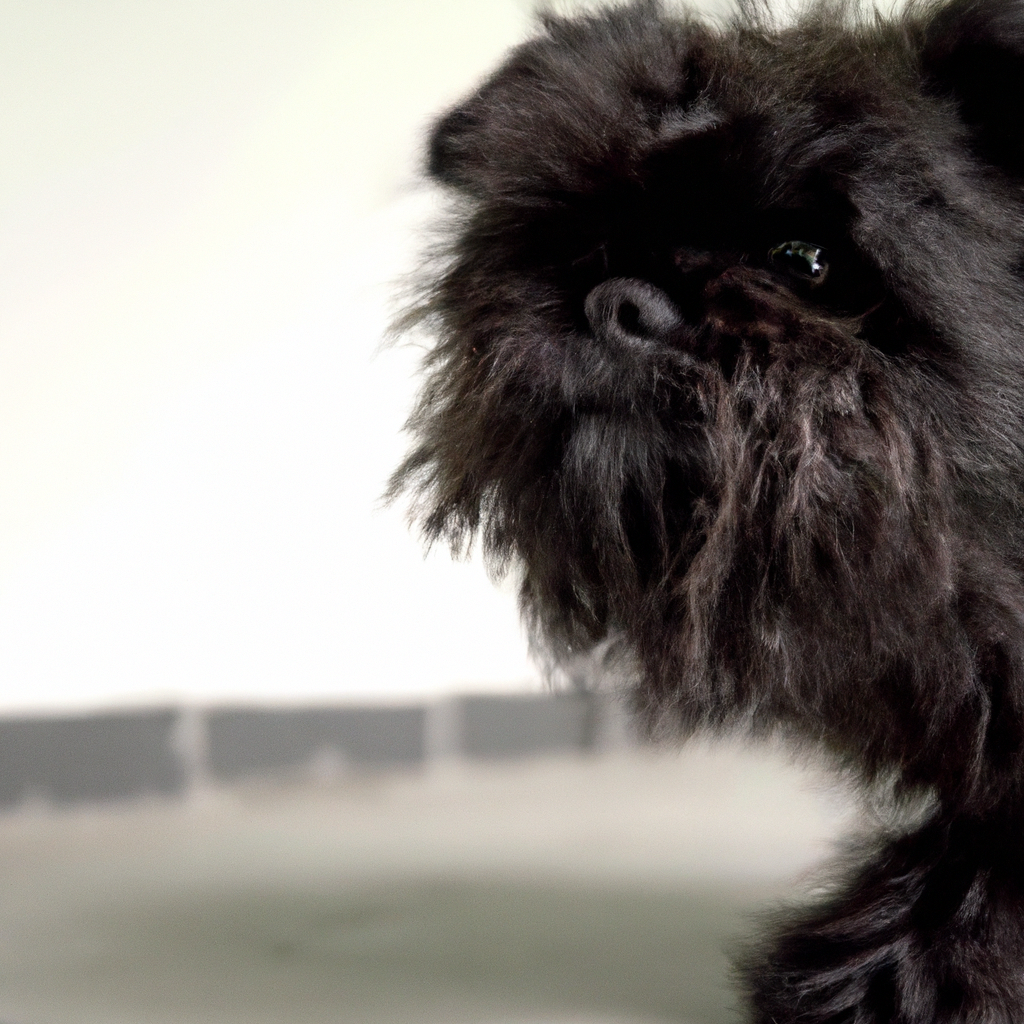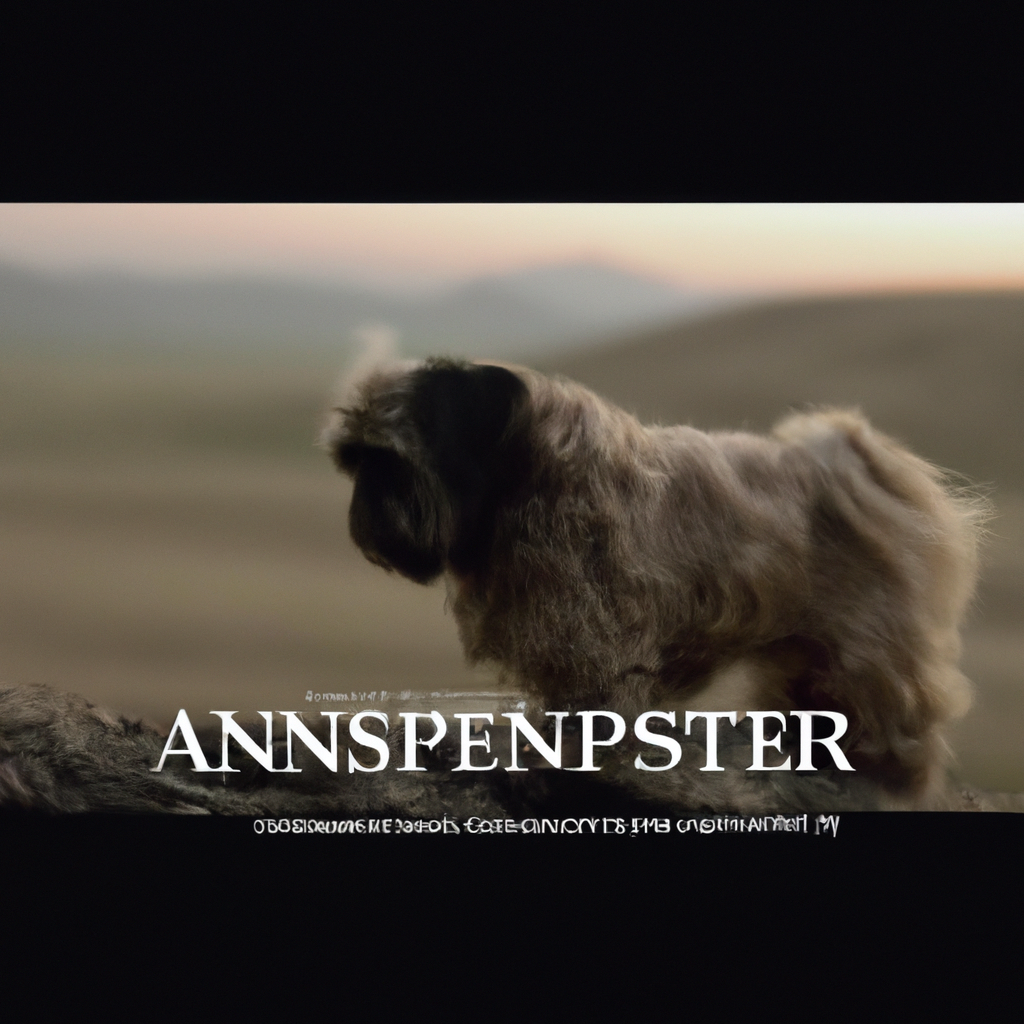Affenpinschers, also known as “Monkey Terriers” or “Monkey Dogs” due to their distinct facial features, are a small breed of dog that originated in Germany in the 17th century. The name “Affenpinscher” translates to “monkey-like terrier” in German, reflecting their simian-like appearance and terrier traits. Initially bred to serve as ratters in homes, stables, and shops, they were later popularized as companion dogs. The Affenpinscher’s lineage includes the Brussels Griffon and the Miniature Schnauzer. Despite their small size, these dogs are known for their fearless nature. The breed was officially recognized by the American Kennel Club in 1936.
The Ancient Roots of Affenpinschers: A Historical Overview
The Affenpinscher, a breed of domestic dog known for its distinctive “monkey-like” face, has a rich and fascinating history that dates back several centuries. This breed, whose name literally translates to “monkey terrier” in German, has been a beloved companion to humans for hundreds of years.
The Affenpinscher’s story begins in the 17th century in Germany, where they were initially bred to serve as ratters in homes and stables. Their small size, agility, and tenacious spirit made them excellent at hunting and killing rats and mice, a task that was of great importance in a time when rodent-borne diseases were a significant threat.
As time went on, the Affenpinscher’s role began to evolve. By the 18th century, these dogs were being bred not just for their ratting abilities, but also for their unique and charming appearance. Their small size, coupled with their wiry coat and distinctive facial features, made them popular pets among the European nobility. They were often depicted in paintings of the time, a testament to their status as cherished companions.
The Affenpinscher’s popularity continued to grow throughout the 19th century. During this time, breeders began to selectively breed Affenpinschers to further refine their appearance. This led to the development of the modern Affenpinscher we know today, with its characteristic round eyes, bushy eyebrows, and shaggy coat.
However, the two World Wars in the first half of the 20th century had a devastating impact on the Affenpinscher breed. Many dog breeds suffered during these times of hardship, and the Affenpinscher was no exception. Their numbers dwindled, and for a time, it seemed as though the breed might disappear entirely.
Thankfully, dedicated breeders in both Europe and America worked tirelessly to revive the breed. They gathered the remaining Affenpinschers and began a careful breeding program to restore their numbers. Their efforts were successful, and by the mid-20th century, the Affenpinscher had made a remarkable comeback.
Today, the Affenpinscher is a beloved breed known for its playful and mischievous nature. They are often described as being “big dogs in small bodies,” a nod to their fearless and energetic personalities. Despite their small size, they are known to be excellent watchdogs, always alert and ready to protect their families.
In conclusion, the Affenpinscher’s journey from a humble ratter to a cherished pet is a testament to the breed’s adaptability and enduring charm. Their distinctive appearance, coupled with their spirited personalities, has ensured their place in the hearts of dog lovers around the world. The Affenpinscher’s history is a fascinating tale of survival and revival, a story that continues to unfold as this remarkable breed continues to charm and delight those who have the pleasure of their company.
Affenpinschers: Tracing Their Origins Back to 17th Century Germany
Affenpinschers, often referred to as “monkey dogs” due to their distinct primate-like appearance, have a rich and fascinating history that dates back to the 17th century in Germany. These small, sturdy dogs, known for their mischievous personality and expressive faces, have been captivating hearts for centuries.
The Affenpinscher’s story begins in Germany, where they were initially bred to serve as ratters in homes and stables. Their small size and agile nature made them perfect for hunting and killing rats and mice, a task they performed with remarkable efficiency. The name “Affenpinscher” itself is derived from the German word “Affe,” which means monkey, and “Pinscher,” which means terrier. This name perfectly encapsulates their monkey-like faces and terrier-like tenacity.
As time passed, the Affenpinscher’s role began to evolve. From being efficient ratters, they transitioned into beloved companions. Their endearing looks and playful nature made them popular among the German nobility in the 18th and 19th centuries. They were often depicted in paintings of the era, showcasing their status as cherished pets.
However, the Affenpinscher’s journey was not always smooth. The breed faced near extinction during World War II. The war had a devastating impact on many dog breeds, and the Affenpinscher was no exception. Their numbers dwindled drastically, and for a time, it seemed like these charming little dogs might disappear forever.
Thankfully, dedicated breeders in the post-war era worked tirelessly to revive the breed. They used surviving Affenpinschers and possibly other small breeds to rebuild the Affenpinscher population. Their efforts were successful, and the breed was saved from the brink of extinction.
The Affenpinscher made its way to America in the early 20th century, and the American Kennel Club officially recognized the breed in 1936. However, it wasn’t until the late 20th century that the breed began to gain popularity in the United States. Today, while they are not as well-known as some other breeds, Affenpinschers have a dedicated following of enthusiasts who appreciate their unique looks and lively personalities.
Despite their small size, Affenpinschers are known for their courage and confidence. They are often described as being “big dogs in small bodies.” They are also known for their loyalty and affection towards their human families. These traits, combined with their distinctive appearance, make them a truly unique breed.
In conclusion, the Affenpinscher’s journey from 17th century German ratters to beloved companions is a testament to their resilience and charm. These “monkey dogs” have faced near extinction and emerged stronger, capturing the hearts of dog lovers around the world. Their history is a fascinating tale of survival and transformation, reflecting the enduring appeal of this remarkable breed. Whether they’re keeping homes free of pests or providing companionship, Affenpinschers continue to make their mark, just as they have for centuries.
The Evolution of Affenpinschers: From Farm Dogs to Show Dogs
The Affenpinscher, a breed of dog that is as unique as its name, has a rich history that dates back several centuries. Known for their distinctive, monkey-like faces, these small but sturdy dogs have evolved from being farm dogs to show dogs, winning hearts and accolades along the way.
The Affenpinscher’s story begins in Germany in the 17th century. The breed’s name, which translates to “monkey terrier” in German, is a nod to their primate-like facial features. Initially, these dogs were larger than the Affenpinschers we know today, and they were primarily used as working dogs on farms. Their primary role was to serve as ratters, hunting and killing rats and other pests that threatened crops and food stores. Their small size, agility, and fearless nature made them excellent at this task.
As time passed, the Affenpinscher began to evolve. Breeders started to selectively breed these dogs to be smaller, aiming to create a more compact dog that could be kept indoors. This was in response to a growing demand among the urban populace for smaller, companion dogs that could live comfortably in city apartments and townhouses. By the late 19th century, the Affenpinscher had shrunk to the size we are familiar with today, and they had begun to transition from being working dogs to companion animals.
The Affenpinscher’s evolution didn’t stop there. As they moved from the farm to the home, their role changed from pest controllers to companions and watchdogs. Their fearless nature and alertness made them excellent guards, while their loyalty and affectionate temperament made them beloved pets. They were particularly popular among women, who often kept them as lap dogs.
The turn of the 20th century saw the Affenpinscher make its debut in the show ring. The breed was officially recognized by the American Kennel Club (AKC) in 1936, and they quickly gained popularity as show dogs. Their unique appearance, combined with their lively personality, made them a hit in the show ring. Despite the interruption of World War II, which led to a temporary decline in the breed, the Affenpinscher bounced back and continued to gain popularity in the post-war years.
Today, the Affenpinscher is a well-established breed that is loved by many for its distinctive looks and charming personality. They are still popular as companion dogs, and they continue to excel in the show ring. In fact, an Affenpinscher named Banana Joe won Best in Show at the prestigious Westminster Kennel Club Dog Show in 2013, cementing the breed’s status as a top show dog.
In conclusion, the Affenpinscher has come a long way from its origins as a farm dog in 17th century Germany. Through selective breeding and changing societal demands, this unique breed has evolved from a working dog to a beloved companion and successful show dog. Despite these changes, the Affenpinscher has retained its distinctive monkey-like face, fearless nature, and loyal temperament, characteristics that continue to endear it to dog lovers around the world.
The Role of Affenpinschers in European History
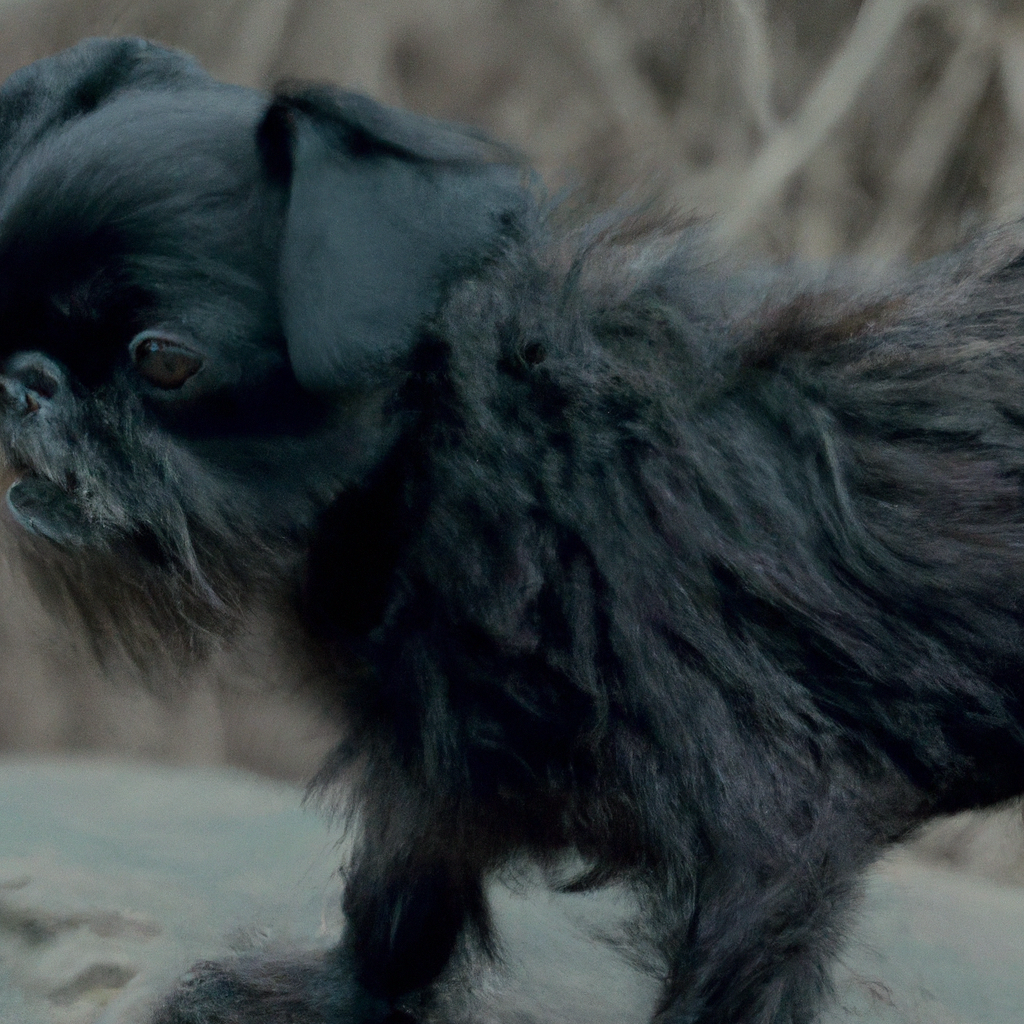
Affenpinschers, often referred to as “Monkey Terriers” or “Monkey Dogs” due to their distinct primate-like appearance, have a rich and fascinating history that dates back several centuries. These small, sturdy dogs, with their unique facial features and playful personalities, have played a significant role in European history, particularly in Germany where they originated.
The Affenpinscher breed is believed to have emerged in the 17th century, although some dog historians argue that their roots could stretch back as far as the 15th century. The name “Affenpinscher” translates to “monkey terrier” in German, a fitting name given their monkey-like expressions. Initially, these dogs were larger than the Affenpinschers we know today, and they were primarily used as ratters, hunting and killing rats and other vermin in homes, stables, and shops. Their small size and agile nature made them perfect for this role.
As time passed, Affenpinschers began to be bred smaller to serve as companion dogs, particularly for women who appreciated their compact size and charming personalities. By the 18th and 19th centuries, Affenpinschers had become popular among the European nobility. They were often depicted in paintings of the era, showcasing their status as cherished pets. Their popularity continued to grow, and they were soon found in households across Europe.
However, the two World Wars in the 20th century had a devastating impact on the breed. Many dog breeds faced near extinction during these times of hardship, and Affenpinschers were no exception. Breeding programs were halted, and the number of Affenpinschers dramatically decreased. It was only through the dedicated efforts of breed enthusiasts that the Affenpinscher was saved from disappearing entirely.
Post-war, the breed slowly began to regain its popularity. The first Affenpinscher was imported to the United States in 1936, and the American Kennel Club officially recognized the breed in 1936. Since then, Affenpinschers have become beloved pets in many American households, appreciated for their loyalty, intelligence, and playful demeanor.
Despite their small size, Affenpinschers have a big personality. They are known for their bold and stubborn nature, often forgetting their size when confronted with larger dogs or threats. They are also incredibly loyal and protective of their families, making them excellent watchdogs. Their intelligence and eagerness to please make them relatively easy to train, although their stubborn streak can sometimes present a challenge.
In recent years, the Affenpinscher has gained more recognition thanks to a particular dog named Banana Joe. This Affenpinscher made headlines in 2013 when he won Best in Show at the Westminster Kennel Club Dog Show, one of the most prestigious dog shows in the world. This win put the Affenpinscher breed in the spotlight and sparked increased interest in these charming little dogs.
In conclusion, the Affenpinscher has a long and storied history, from its origins as a rat hunter in Germany to its status as a beloved pet and show dog. Despite facing near extinction during the World Wars, the breed has managed to survive and thrive, thanks to the efforts of dedicated breed enthusiasts. Today, Affenpinschers continue to win hearts with their unique looks, playful personalities, and unwavering loyalty.
Affenpinschers in Art: Depictions from the 18th and 19th Centuries
The Affenpinscher, a small but mighty breed, has a rich history that dates back several centuries. This breed, known for its distinctive monkey-like face, has been a beloved companion for many over the years. But did you know that the Affenpinscher also has a fascinating presence in the world of art? Indeed, the Affenpinscher has been depicted in various forms of art, particularly during the 18th and 19th centuries.
The Affenpinscher, which translates to “monkey terrier” in German, originated in Germany in the 17th century. However, it wasn’t until the 18th and 19th centuries that this breed began to make appearances in art. During this time, the Affenpinscher was often portrayed in paintings, drawings, and even sculptures. These artistic depictions provide us with a unique glimpse into the breed’s history and evolution.
In the 18th century, the Affenpinscher was often depicted as a larger, rough-coated dog used for working purposes. These early depictions show the breed as it was originally intended: a ratter, used to keep kitchens, stables, and shops free from rodents. The Affenpinscher’s fearless nature and tenacious spirit were perfectly suited for this task, and these traits are still evident in the breed today.
As we move into the 19th century, the Affenpinscher begins to appear more frequently in art, reflecting its growing popularity as a companion dog. The breed’s size appears to decrease in these depictions, likely due to selective breeding for a smaller, more companionable dog. The Affenpinscher’s distinctive features, such as its wiry coat and expressive eyes, are more pronounced in these later works of art.
One notable example of the Affenpinscher in 19th-century art is a painting by the famous French artist, Édouard Manet. In his work “Olympia,” a reclining nude woman is accompanied by a small black dog at her feet. While the breed of the dog is not specified, many art historians believe it to be an Affenpinscher due to its distinctive features and size.
The Affenpinscher’s presence in art during the 18th and 19th centuries is a testament to the breed’s enduring appeal. From its early days as a working dog to its later role as a beloved companion, the Affenpinscher has captured the hearts of many. These artistic depictions not only provide us with a historical record of the breed but also highlight the Affenpinscher’s unique charm and character.
In conclusion, the Affenpinscher’s journey from a working dog to a cherished pet is beautifully chronicled in the art of the 18th and 19th centuries. These artistic depictions serve as a window into the past, allowing us to appreciate the breed’s evolution and enduring appeal. Whether portrayed as a fearless ratter or a beloved companion, the Affenpinscher’s distinctive features and spirited personality shine through, making it a captivating subject in the world of art.
The Affenpinscher’s Journey: From Rat Hunters to Beloved Pets
The Affenpinscher, a small but mighty breed, has a rich and fascinating history that dates back several centuries. Known for their distinctive, monkey-like faces, these dogs have journeyed from being rat hunters to becoming beloved pets in homes worldwide.
The Affenpinscher’s story begins in Germany in the 17th century. The breed’s name, which translates to “monkey terrier” in German, is a nod to their unique, simian-like facial features. Initially, these dogs were bred to be working dogs, specifically to hunt and kill rats. Their small size, agility, and tenacity made them perfect for this role. They were often found in stables, shops, and homes, where they would keep the rat population under control.
As time went on, the Affenpinscher’s role began to evolve. By the 18th and 19th centuries, they were being bred to be smaller and more companionable. This shift was largely due to the changing societal norms of the time. As the middle class began to rise, there was an increased demand for small, companion dogs that could live comfortably in urban homes. The Affenpinscher, with its small size and lively personality, fit the bill perfectly.
However, the transition from rat hunter to companion dog wasn’t entirely smooth. The breed’s popularity waxed and waned over the years, and at times, the Affenpinscher was on the brink of extinction. World War I and II, in particular, were challenging times for the breed. Many dog breeds suffered during these periods due to food shortages and the general chaos of war, and the Affenpinscher was no exception.
Despite these challenges, the Affenpinscher managed to survive, thanks in large part to the efforts of dedicated breeders. After World War II, breeders in both Europe and America worked tirelessly to revive the breed. They were successful, and by the mid-20th century, the Affenpinscher was once again thriving.
Today, the Affenpinscher is known and loved for its distinctive appearance and charming personality. These dogs are small but sturdy, with a thick, wiry coat and a face that’s often described as “comically serious.” They’re known for their loyalty, intelligence, and playful nature. While they may no longer be hunting rats, their tenacity and courage are still very much a part of their character.
In recent years, the Affenpinscher has even found success in the show ring. In 2013, an Affenpinscher named Banana Joe won Best in Show at the Westminster Kennel Club Dog Show, one of the most prestigious dog shows in the world. This win brought a lot of attention to the breed and helped to further increase its popularity.
The Affenpinscher’s journey from rat hunter to beloved pet is a testament to the breed’s adaptability and resilience. These dogs have managed to navigate the changing tides of history and come out on top. Whether they’re keeping a home free of rats or winning top honors at a dog show, Affenpinschers do it all with a unique blend of seriousness and charm that’s all their own. It’s no wonder that this breed, with its rich history and distinctive personality, has captured the hearts of dog lovers around the world.
The Influence of World Wars on Affenpinscher Breeding
The history and origin of Affenpinschers, a breed of small dogs known for their monkey-like faces, is a fascinating tale that intertwines with the broader narrative of world history. In particular, the influence of the World Wars on Affenpinscher breeding is a compelling chapter in this story.
Affenpinschers, also known as “Monkey Terriers,” originated in Germany in the 17th century. They were initially bred to be ratters, hunting and killing rats in homes and stables. However, their charming looks and playful personalities soon made them popular as companion dogs. Despite their popularity, the breed’s existence was threatened during the World Wars, a period that had a profound impact on Affenpinscher breeding.
The onset of World War I in 1914 brought about significant changes in Europe, and the world of dog breeding was not immune to these shifts. As resources became scarce and priorities shifted towards the war effort, breeding dogs, including Affenpinschers, was no longer a priority. This led to a decline in the number of Affenpinschers, and by the end of the war, the breed was on the brink of extinction.
The period between the two World Wars saw a slight resurgence in Affenpinscher breeding. Breeders, recognizing the unique qualities of these dogs, made efforts to revive the breed. However, the outbreak of World War II in 1939 once again put a halt to these efforts. The war years were a time of hardship and uncertainty, and the breeding of Affenpinschers, like many other breeds, was severely impacted.
The aftermath of World War II was a challenging time for Affenpinscher breeding. The breed had suffered greatly during the war years, and their numbers were critically low. However, dedicated breeders were determined not to let the Affenpinscher disappear. They worked tirelessly to rebuild the breed, often using dogs that were not pure Affenpinschers to increase their numbers. This period of rebuilding was crucial in shaping the Affenpinscher breed as we know it today.
The influence of the World Wars on Affenpinscher breeding is a testament to the resilience of both the breed and the breeders. Despite the challenges and setbacks, the breed managed to survive and thrive. Today, Affenpinschers are cherished for their unique looks and lively personalities. They are popular show dogs and beloved pets, a far cry from their days as ratters.
The story of Affenpinschers is a reminder of the impact of historical events on all aspects of life, including dog breeding. It’s a tale of survival and resilience, of a breed that faced extinction but managed to bounce back, thanks to the dedication and efforts of breeders. The Affenpinscher’s journey from the brink of extinction to popularity is a testament to the breed’s charm and appeal, and to the breeders’ commitment to preserving this unique breed.
In conclusion, the history and origin of Affenpinschers, and the influence of the World Wars on their breeding, is a fascinating tale. It’s a story that intertwines with the broader narrative of world history, and a reminder of the resilience and adaptability of both dogs and humans. Today, as we enjoy the company of these charming and playful dogs, we can appreciate the journey they have taken to reach us.
The Rise of Affenpinschers in American Popularity: A Historical Perspective
The Affenpinscher, a breed of domestic dog known for its distinctive “monkey-like” face, has a rich and fascinating history that dates back several centuries. Originating in Germany, the Affenpinscher was initially bred to serve as a ratter, a dog that was tasked with hunting and killing rats, mice, and other vermin. Over time, however, the Affenpinscher’s role evolved, and it became a beloved companion animal, prized for its loyalty, intelligence, and unique appearance.
The Affenpinscher’s journey to America and subsequent rise in popularity is a story that mirrors the broader trends in American society and culture. The first Affenpinschers arrived in the United States in the early 20th century, brought over by German immigrants who valued the breed for its hardiness and adaptability. However, it wasn’t until the mid-20th century that the breed began to gain widespread recognition and popularity.
The post-World War II era was a time of significant change in America. The economy was booming, and many families were moving to the suburbs and starting families. Dogs, which had long been valued for their practical uses such as hunting or guarding, were increasingly seen as companions and members of the family. This shift in attitudes towards dogs created a demand for breeds that were not only useful but also friendly, loyal, and good with children.
The Affenpinscher, with its small size, playful nature, and distinctive appearance, fit the bill perfectly. The breed’s popularity began to rise steadily, and by the 1950s and 60s, Affenpinschers were a common sight in American homes. The American Kennel Club (AKC), the leading authority on dog breeds in the United States, officially recognized the Affenpinscher in 1936, further cementing its status as a desirable breed.
However, the Affenpinscher’s rise in popularity was not without its challenges. The breed’s unique appearance and playful nature made it a target for unscrupulous breeders who sought to capitalize on its popularity by producing puppies quickly and without regard for their health or well-being. This led to a backlash among dog lovers and breed enthusiasts, who worked tirelessly to protect the breed and ensure its future.
Today, the Affenpinscher remains a popular choice among dog owners in America. The breed’s unique combination of traits – its small size, playful nature, and distinctive “monkey-like” face – continue to endear it to people of all ages and walks of life. Despite the challenges it has faced, the Affenpinscher’s story is ultimately one of success. From its humble beginnings as a ratter in Germany to its status as a beloved companion animal in America, the Affenpinscher has proven itself to be a breed that is not only adaptable but also resilient.
In conclusion, the Affenpinscher’s rise in American popularity is a testament to the breed’s unique qualities and the enduring appeal of dogs as companions and family members. As we look to the future, it’s clear that the Affenpinscher will continue to hold a special place in the hearts of dog lovers across America.In conclusion, Affenpinschers, also known as “Monkey Terriers”, have a rich history that dates back to the 17th century in Germany. They were originally bred to serve as ratters in homes, stables, and shops. Over time, they were miniaturized and became companion dogs for ladies in society. Despite their small size, Affenpinschers are known for their fearless nature, which is a testament to their original breeding purpose. Their unique appearance and personality have made them a beloved breed worldwide.

